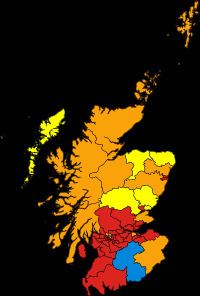5 May 2005 (2005-05-05) 2010 → 46 9 922,402 528,076 Start date May 5, 2005 | 56 Seats 10 Seats 41 11 39.5% 22.6% | |
 | ||
Winner Tony Blair | ||
These are the Scottish results of the United Kingdom general election, 2005. The election was held on 5 May 2005 and all 59 seats in Scotland were contested. This was the first election to occur under the new boundaries that were imposed which reduced the number of Scottish seats from 72 to 59.
Contents
Changes
Several years after the Scottish Parliament had been established by the Scotland Act 1998, the target electorate (population) size of Westminster Parliamentary seats in Scotland was adjusted to bring it in line with England's constituencies. Before this reform Scotland had a smaller target electoral size per constituency resulting in more seats per head of population, which had been intended to compensate Scotland for its status as a nation, its lower population density (which causes larger constituencies geographically), its distance from the seat of Parliament in Westminster and finally, because prior to 1999 Scottish law had been wholly determined by the Westminster Parliament. These problems were perceived to have been addressed with the establishment of the Scottish Parliament in 1999.
The Boundary Commission for Scotland therefore produced a plan in 2003 in which there would be 59 constituencies, reduced from 72. In 2004, Parliament passed the Scottish Parliament (Constituencies) Act 2004 which instituted these changes and broke the link between British and Scottish Parliamentary constituencies.
Three constituencies were left unchanged — the island seats of Orkney and Shetland, the Western Isles, though the latter changed its official name to the Gaelic "Na h-Eileanan an Iar", and Eastwood, which changed its name to "East Renfrewshire". Several other new constituency names were also implemented; in all these cases the new seats had altered boundaries.
Predictions
Although it was impossible to guarantee a wholly accurate prediction of the strength of the parties within the 59 new Scottish constituencies, estimates had been made prior to the poll on 5 May on the basis of a ward-by-ward breakdown of local council election results. An agreed set used by all media reports and most political commentators suggested that had the new boundaries been in effect in the 2001 election, Labour would have won forty-six seats, the Liberal Democrats nine, the Scottish National Party four, and the Conservatives none. This would have represented a loss of ten seats for Labour and one each for the Liberal Democrats, Scottish National Party and the Conservatives. The arithmetic was however complicated by the fact that the boundary revision had produced some seats that were notionally highly marginal.
The results of the 2005 election showed some of the highest changes of the share of the vote for particular parties occurring in Scottish seats, leading some commentators to speculate that either the notional results were in error and/or they were unable to take into account factors such as tactical voting and people voting differently between General and Local Elections.
Results
Labour won 41 seats, the Liberal Democrats 11, the Scottish National Party six, and in Dumfriesshire, Clydesdale and Tweeddale the Conservatives won their only Scottish seat. Compared to the actual results of 2001 this meant a loss of fourteen seats for Labour, a gain of one seat for the SNP and Liberal Democrats, and no change for the Conservatives.
Results in Scotland for Labour were also down, though less so than in England. Labour lost approximately 4% of the vote in East Scotland and approximately 6% of the vote in West Scotland. Labour's vote declined the most in the Edinburgh area and in the north of Scotland (where Labour lost all of its rural seats).
The Conservative vote declined marginally in both East and West Scotland, but the Conservatives nonetheless managed to win a seat in the South (Dumfriesshire, Clydesdale and Tweeddale), so maintaining their one Scottish seat in the Westminster Parliament. Having once been the largest party in Scotland (most recently in 1959), the 2001 and 2005 General Elections have done very little to reverse the downward trend that culminated in the 1997 loss of all eleven Conservative seats.
The Liberal Democrats made gains against Labour in both regions of Scotland and picked up a modest number of seats. On average, their vote rose approximately 5% across Scotland, though again this translated into few gains as the Liberal Democrat vote was not particularly concentrated.
The Scottish National Party's vote declined slightly across Scotland, but they managed to win one rural and one urban seat from Labour.
The Socialist Labour Party achieved its highest ever result in one constituency, gaining 14.5% of the votes cast in Glasgow North East.
See also the list of parties standing in Scotland.
